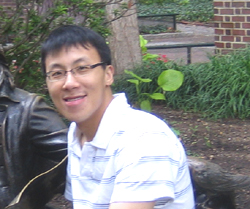Protease-Triggered Nanoparticle Aggregation for Improved Cancer Imaging and Therapy.
Dominic Yee
Appointment Period: 2006-2008 / Grant Year: [22,23]
 Growth and development of breast cancer involves the overexpression of a variety of growth factors and enzymes that we seek to exploit to more specifically deliver imaging and therapeutic agents for cancer. The investigation and development of new mechanisms for aggregating nano-sized molecules and materials in the vicinity of cancer has the potential to improve cancer diagnosis and treatment by specifically localizing imaging and therapeutic agent delivery to diseased sites. The “trigger” for nanoparticle aggregation and localization was based on overexpressed cancer-related enzymes, specifically proteases, that are implicated to be involved in remodeling of the vasculature and that are a precursor for cancer invasion.
Growth and development of breast cancer involves the overexpression of a variety of growth factors and enzymes that we seek to exploit to more specifically deliver imaging and therapeutic agents for cancer. The investigation and development of new mechanisms for aggregating nano-sized molecules and materials in the vicinity of cancer has the potential to improve cancer diagnosis and treatment by specifically localizing imaging and therapeutic agent delivery to diseased sites. The “trigger” for nanoparticle aggregation and localization was based on overexpressed cancer-related enzymes, specifically proteases, that are implicated to be involved in remodeling of the vasculature and that are a precursor for cancer invasion.
A protease-labile masking linker was used to hinder interaction of two orthogonal components with strong affinity to each other. Upon cancer-related enzymatic activity, the masking linker is released and the strong interaction of components on nanoparticles restored. To date, a mechanism based on the bacterial interaction with antibiotic vancomycin was discovered to be applicable as an orthogonal pair. Furthermore, a labile masking linker utilizing a common motif used in peptide synthesis was found useful for hindering the vancomycin interaction. Work in progress involves the synthesis and characterization of diverse nanoparticle agents for attachment to directing ligands described, in addition to imaging and therapeutic moieties. The discovery and development of novel mechanisms for nanoparticle aggregation of nano-sized imaging and therapeutic agents has the potential to enable better localization of therapeutics to regions of breast cancer and metastases.
 Growth and development of breast cancer involves the overexpression of a variety of growth factors and enzymes that we seek to exploit to more specifically deliver imaging and therapeutic agents for cancer. The investigation and development of new mechanisms for aggregating nano-sized molecules and materials in the vicinity of cancer has the potential to improve cancer diagnosis and treatment by specifically localizing imaging and therapeutic agent delivery to diseased sites. The “trigger” for nanoparticle aggregation and localization was based on overexpressed cancer-related enzymes, specifically proteases, that are implicated to be involved in remodeling of the vasculature and that are a precursor for cancer invasion.
Growth and development of breast cancer involves the overexpression of a variety of growth factors and enzymes that we seek to exploit to more specifically deliver imaging and therapeutic agents for cancer. The investigation and development of new mechanisms for aggregating nano-sized molecules and materials in the vicinity of cancer has the potential to improve cancer diagnosis and treatment by specifically localizing imaging and therapeutic agent delivery to diseased sites. The “trigger” for nanoparticle aggregation and localization was based on overexpressed cancer-related enzymes, specifically proteases, that are implicated to be involved in remodeling of the vasculature and that are a precursor for cancer invasion.